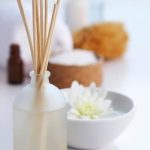Are you looking to create your own aromatherapy oil roll on? In this article, we will guide you through the process of making a personalized aromatherapy blend in roll on form. Aromatherapy is the practice of using essential oils to improve physical, emotional, and mental well-being. When used in roll on form, essential oils can provide targeted relief and relaxation, making it a convenient and accessible way to enjoy the benefits of aromatherapy on-the-go.
In order to create an effective aromatherapy oil roll on, it is important to choose the right essential oils that suit your needs. Different essential oils have specific properties that can address various concerns such as stress relief, improved focus, or soothing sore muscles. Understanding the properties of different essential oils will allow you to create a personalized blend that caters to your individual preferences and needs.
Furthermore, carrier oils play a crucial role in aromatherapy roll ons as they dilute the potent essential oils and make them safe for topical application. The choice of carrier oil can also affect the overall scent and consistency of the roll on blend. By understanding the significance of carrier oils and choosing high-quality options, you can ensure that your aromatherapy oil roll on is safe and effective for use.
Choosing the Right Essential Oils
When it comes to making aromatherapy oil roll ons, choosing the right essential oils is crucial. Each essential oil has its own unique properties and benefits, so it’s important to understand what each one offers in order to create an effective blend. Some popular essential oils used in aromatherapy roll ons include lavender, peppermint, eucalyptus, and tea tree.
Lavender essential oil is known for its calming and relaxing properties, making it a great choice for relieving stress and promoting better sleep. Peppermint essential oil has invigorating and cooling effects, which can help with headaches and muscle aches.
Meanwhile, eucalyptus essential oil is often used for its respiratory benefits, as it can help with congestion and sinus issues. Tea tree essential oil is commonly used for its antimicrobial and antiseptic properties, making it a good choice for skin blemishes or minor cuts.
When creating a roll on blend, it’s important to consider the desired effect you want to achieve. For example, if you’re looking to make a roll on for relaxation and sleep support, a blend of lavender and chamomile essential oils would be ideal. On the other hand, if you’re aiming for an energizing blend, combining peppermint and citrus essential oils would be more fitting.
Understanding Carrier Oils
Carrier oils play a crucial role in aromatherapy roll ons as they help dilute and carry the essential oils onto the skin. They are often used as a base for creating roll on blends and can also provide additional benefits to the skin. When choosing carrier oils, it’s important to consider factors such as skin type, aroma, and therapeutic properties.
Some of the best carrier oils to use in aromatherapy roll ons include:
1. Jojoba Oil: Known for its similarity to the natural oils produced by the skin, making it easily absorbed without clogging pores. It is often used for its moisturizing and anti-inflammatory properties.
2. Sweet Almond Oil: This light and slightly nutty oil is an excellent choice for most skin types and is high in vitamin E, making it great for nourishing and conditioning the skin.
3. Coconut Oil: Solid at room temperature, coconut oil can be melted down for use in roll ons. It has antimicrobial and antifungal properties, making it ideal for skin health.
4. Grapeseed Oil: With a light texture and mild aroma, grapeseed oil is rich in antioxidants and has astringent properties, making it suitable for oily or acne-prone skin.
When making an aromatherapy oil roll on, it’s important to choose carrier oils that complement the specific essential oils being used. For example, if creating a calming blend with lavender essential oil, using a light and soothing carrier oil like sweet almond oil would be a good choice as it enhances the overall calming effect of the blend.
It’s worth noting that some carrier oils have longer shelf lives than others due to their stability against oxidation. Jojoba oil and coconut oil are examples of carriers with longer shelf lives, while lighter carriers like almond or grapeseed oils have shorter shelf lives but are still valuable options when used within their recommended timeframes.
| Carrier Oils | Properties |
|---|---|
| Jojoba Oil | Similarity to natural skin oils; moisturizing; anti-inflammatory |
| Sweet Almond Oil | Nourishing; conditioning; high in Vitamin E |
| Coconut Oil | Antimicrobial; antifungal; suitable for skin health |
| Grapeseed Oil | Light texture; mild aroma; rich in antioxidants; astringent properties |
Tools and Supplies Needed
To make your own aromatherapy oil roll on, you will need the following tools and supplies:
- Roller Bottles: These are small glass bottles with a roller ball applicator on top. It is important to choose dark-colored bottles, such as amber or cobalt blue, to protect the essential oils from light and preserve their potency.
- Labels: You will need labels to mark your roll on blend. This is especially important if you plan on making multiple roll ons with different blends, as it will help you easily identify each one.
- Measuring Tools: A small funnel and measuring spoons or droppers will be essential for accurately measuring out your essential oils and carrier oils when creating your blend.
- Essential Oils: Choose high-quality essential oils that are 100% pure. You can select a single essential oil or create a blend of multiple oils depending on your desired benefits and scent preferences.
In addition to these basic supplies, you may also want to consider having mixing bowls, stirring utensils, and a notepad and pen handy for keeping track of your recipes and blends. These tools will help ensure that you can create a consistent roll on blend each time.
Now that you have gathered all the necessary tools and supplies, let’s move on to the step-by-step guide on how to make an aromatherapy oil roll on using these items.
Step-by-Step Guide to Making the Roll On
To create your own aromatherapy oil roll on, you will need a few key ingredients and supplies. Below is a step-by-step guide on how to make an aromatherapy oil roll on:
1. Choose your essential oils: When making an aromatherapy oil roll on, it’s crucial to choose the right essential oils for your specific needs. For relaxation and stress relief, consider using lavender or chamomile essential oil. For an energy boost, try using citrus oils such as lemon or orange. Research different essential oils and their properties to determine which ones will best suit your desired outcome.
2. Select your carrier oil: Carrier oils are important in diluting essential oils and ensuring they are safe for skin application. Some popular carrier oils include sweet almond oil, fractionated coconut oil, and jojoba oil. Consider the properties of each carrier oil and how they may complement the essential oils you have chosen for your blend.
3. Mix your essential oils with the carrier oil: Once you have selected your essential oils and carrier oil, it’s time to mix them together to create your aromatherapy blend. A general rule of thumb is to use approximately 15-20 drops of essential oil per 10ml of carrier oil, but be sure to check specific guidelines for each individual oil.
4. Fill the roller bottle: Using a small funnel or dropper, carefully fill your roller bottle with the blended mixture of essential and carrier oils. Be sure to leave a small amount of room at the top to insert the roller ball and prevent spillage.
5. Label and store: Once your roller bottle is filled with your custom aromatherapy blend, label it with the name of the blend and date it was made so that you can keep track of which blends work best for you over time.
By following these steps on how to make an aromatherapy oil roll on, you can create a personalized and effective way to benefit from the therapeutic properties of essential oils throughout your day.
Tips for Blending Essential Oils
When creating aromatherapy oil roll ons, it’s essential to understand the art of blending essential oils to create a balanced and effective blend. The right combination of essential oils can enhance the therapeutic benefits of the roll on, promoting relaxation, improving mood, and providing other health benefits. Here are some tips and tricks for blending essential oils for roll ons:
Start With a Purpose
Before you start blending essential oils for your roll on, it’s important to have a clear purpose in mind. Whether you want to create a relaxing blend for stress relief, an energizing blend for focus and mental clarity, or a soothing blend for headaches, having a specific goal will guide your oil selection.
Consider the Scent Profile
When creating an aromatherapy oil roll on, consider the scent profile of each essential oil and how they will complement each other. For example, floral scents like lavender and geranium can pair well with citrusy scents like lemon and bergamot, while earthy scents like cedarwood and patchouli can be balanced with herbal scents like rosemary and peppermint.
Follow Proper Dilution Guidelines
It’s crucial to follow proper dilution guidelines when blending essential oils for roll ons. This ensures that the final blend is safe for topical application. The typical recommended dilution ratio is 2-3% essential oil to carrier oil for adult use. For example, if you’re using a 10ml roller bottle, this would equate to 6-9 drops of essential oil.
By following these tips and tricks for blending essential oils, you can create custom aromatherapy oil roll ons tailored to your specific needs and preferences. Experimenting with different combinations of essential oils will allow you to discover unique blends that promote overall well-being and address specific concerns such as stress relief or headache relief.
Proper Use of Aromatherapy Oil Roll On
Apply to Pulse Points
When using an aromatherapy oil roll on, it is best to apply the essential oil blend to pulse points. These areas include the wrists, temples, and neck. The warmth of these pulse points helps to release the aroma of the essential oils, allowing you to fully experience their benefits. Gently roll the oil onto these areas and then lightly massage the oil into your skin for best results.
Avoid Sensitive Areas
It is important to avoid applying aromatherapy oil roll ons to sensitive areas such as the eyes, mucous membranes, and broken or irritated skin. Essential oils are highly concentrated and can cause irritation if applied to these areas. Be mindful of where you apply the roll on and if any irritation occurs, discontinue use immediately.
Reapply as Needed
The effects of aromatherapy oil roll ons may fade over time, so it is okay to reapply as needed throughout the day. If you find that the scent has faded or if you desire a stronger effect, simply reapply the roll on to your pulse points. However, be mindful not to overdo it as too much application can be overwhelming.
By following these best practices for using and applying aromatherapy oil roll ons, you can maximize the benefits of your essential oil blends while ensuring a safe and enjoyable experience.
Safety Precautions and Storage
In conclusion, creating your own aromatherapy oil roll on can be a fun and rewarding experience, allowing you to customize a blend that suits your specific needs and preferences. With the right essential oils, carrier oils, and tools, you can easily make your own roll on at home. By following the step-by-step guide provided in this article, you can ensure that you are incorporating the best practices for creating a safe and effective product.
It is important to remember that essential oils are potent substances and should be handled with care. Always research the specific properties and contraindications of each essential oil before creating a blend. Additionally, it’s crucial to store your aromatherapy oil roll ons in a cool, dark place to maintain their potency and shelf life. Properly labeling each roll on with the ingredients used will also help ensure safety when using different blends.
Incorporating aromatherapy into your daily routine can provide numerous benefits for overall well-being. Whether you’re looking to relax, uplift your mood, or alleviate minor ailments, an aromatherapy oil roll on can be a convenient and effective way to enjoy the therapeutic properties of essential oils. With the knowledge gained from this article, you now have the tools to create your own personalized blends and enjoy the benefits of aromatherapy wherever you go.
Frequently Asked Questions
How Do You Make Essential Oil Roll Ons?
To make essential oil roll ons, you will need a roll-on bottle, essential oils, and a carrier oil. Start by adding your chosen essential oils to the roll-on bottle, filling about 10-15% of the bottle. Then, fill the rest with the carrier oil.
What Is the Ratio of Essential Oils to Roll On?
The ratio of essential oils to roll on is usually around 10-15% of the total volume of the roll-on bottle. This means that if you have a 10ml roll-on bottle, you would use around 1-1.5ml of essential oils.
What Is the Best Carrier Oil for Essential Oil Roll On?
The best carrier oil for essential oil roll ons depends on personal preference and skin type, but popular choices include fractionated coconut oil, jojoba oil, sweet almond oil, and grapeseed oil. These carrier oils are light and easily absorbed into the skin, making them ideal for roll ons.

Are you looking for a natural way to improve your health and wellbeing?
If so, aromatherapy may be the answer for you.






